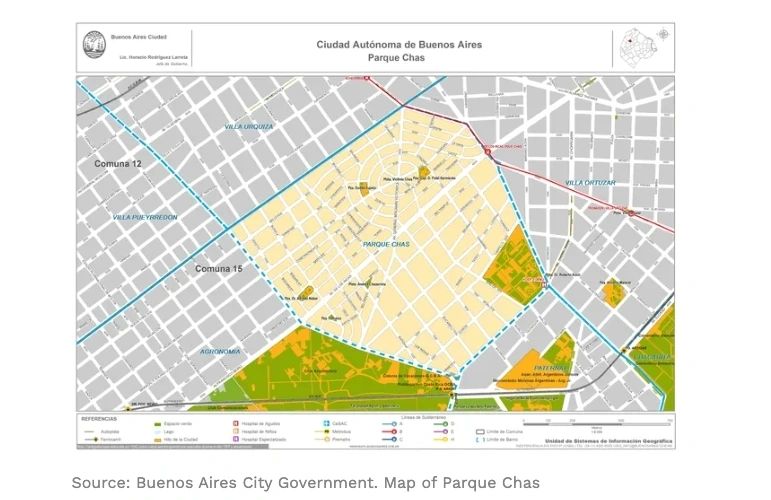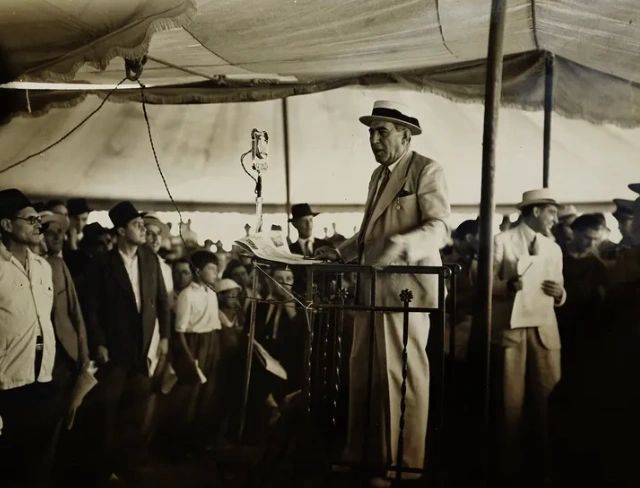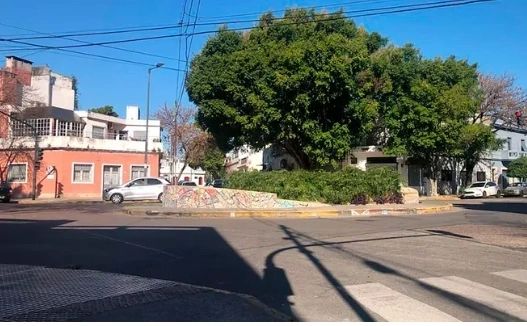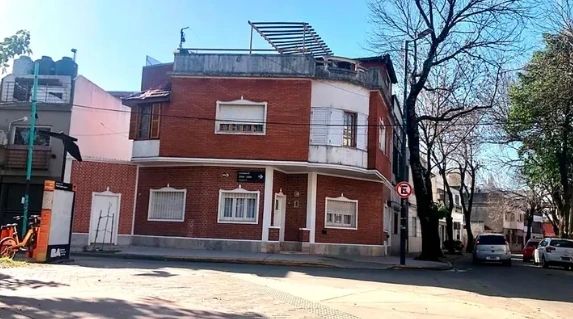BuySellBA
Administrator
The only labyrinthine neighborhood in Buenos Aires City is approaching 100 years old: where is it and how much does it cost to live there? - La Nacion Propiedades

Source:

 www.ambito.com
www.ambito.com
July 28, 2025
By Jose Luis Cieri
It was spun off from Agronomía. It was designed by Frehner and Guerrico. Its tree-lined, circular streets bear the names of European cities, and are dominated by houses and townhouses.

Aerial view of the circular Parque Chas layout. It's the only neighborhood with a labyrinthine layout in the city of Buenos Aires and the entire country.Fernando Burelli (@ferbure IG)
Parque Chas has been one of the most coveted neighborhoods in Buenos Aires for decades . This residential layout of low-rise buildings possesses a unique charm. Its winding streets, named after European cities, form a veritable urban labyrinth that distinguishes it from the rest of the city and is unique in Argentina. It's a sought-after area because of its predominantly houses and townhouses nestled in a tranquil, tree-lined setting , offering good prices in a revitalized real estate market .
Its center is crossed by a diagonal: General Benjamín Victorica Street, formerly called Vicente Chas and, earlier, La Internacional. That same name remains on the central square and fountain, in homage to Vicente Chas, the original owner of the land where this unique urban development project was developed.
They chose a radially centric design, with a central roundabout and curved streets, inspired by the late 19th-century English garden city model. This type of urban design, influenced by the tenets of English town planning, sought to harmonize urban life with the natural environment. It aimed not only to improve circulation and the use of space, but also to foster community life.

Along its 60 blocks, peculiarities stand out, such as Berlín Street, which traces a complete circle, or the intersection of Bauness and Bauness, where one street crosses itself. At Gándara and Ginebra streets, two houses share a single corner. There is also a corner with six vertices, another rarity within the Buenos Aires checkerboard.
The first 20 houses were built for workers. At the same time, a project to modify the layout was approved. Then came the subdivisions of the auctioneer GG Grosso , whose real name is still unknown. In November 1927, he led the grand opening auction with a striking slogan: "Parque Chas Neighborhood, unique in South America." His advertisements highlighted the "English-style" layout, the proximity to the then-brand-new Tornú Hospital, and the possibility of building family homes on affordable lots.

The auctioneer and auctioneer GG Grosso (his first name is unknown) when the first plots of land were being marketed to create what is now Parque Chas (Architect Magdalena Eggers)
The auction took place in tents set up on the grounds, with a large display of flags, leaflets, and public speeches.
Both the design and the nomenclature of the streets are distinctive. The existing names were retained, and in 1933, the City Council passed an ordinance naming the new streets. Some of these were Geneva, The Hague, Dublin, Trier, Turin, Moscow, Belgrade, Bucharest, and International Street, the latter now called Victorica. This choice of names was not accidental: the neighborhood aspired to establish itself as a cosmopolitan, modern, and progressive corner within the emerging urban fabric of Buenos Aires.
For decades, Parque Chas maintained a low profile. Although its residents strongly identified with the area, administratively it remained under the jurisdiction of the Agronomía neighborhood. In 1976, during the civil-military dictatorship, a decree by Mayor Osvaldo Cacciatore eliminated its neighborhood status. It wasn't until 2005, thanks to neighborhood support and the passage of Law 1907, that Parque Chas formally regained its autonomy.

Publication from almost 100 years ago and public meeting for the auction of the land - Architect Magdalena Eggers
Architect Magdalena Eggers , who leads guided tours of the neighborhood and wrote her master's thesis on the subject ("They will live in paradise," referring to a sales slogan used by Grosso), explained that Parque Chas was the last neighborhood to be officially established in the city. "We found an ordinance from January 1976 that named it a neighborhood, but it was repealed by decree six months later. We revived that ordinance to recover the neighborhood," she explained.
“The pioneers sought narrow streets to foster neighborhood ties. That remains the case: there's a strong bond between neighbors, and that attracts those looking for homes in the area,” Eggers remarked. He also emphasized that the morphology of the neighborhood's “original core,” with its curved alleys and small lots, remains almost intact.

Its tree-lined, winding streets are unique in Buenos Aires and the country, and exude tranquility (Photo courtesy of @BuenosAiresalPaso)
Román Andrés Paikin , of San Román Properties, emphasized that “this residential area of low-rise houses functions as a gated community. Curved, circular streets named after European cities branch out from its center, creating a labyrinthine route. If you're unfamiliar with the neighborhood, you'll likely need a GPS to find your way around.”
Currently, the most sought-after residential areas are within the area delimited by De los Incas, Triunvirato, La Pampa, and Andonaegui avenues. The urban planning code classifies it as a Determined Urbanization (U 39), subject to comprehensive regulations regarding use, occupancy, subdivision, and aesthetics. This limits high-rise construction and preserves the neighborhood's scale.

Vicente Chas Square, where six corners and Gándara, Victorica, and Ávalos streets meet (Photo: San Román Properties)
Residents prioritize houses, townhouses, and duplexes, avoiding buildings (although there are some near the labyrinth area). Tranquility and a residential profile are core values. Even so, Parque Chas is well connected to the city: the Avenida De los Incas – Parque Chas station on Line B and the bus routes along Incas, Triunvirato, and La Pampa ensure easy access.
Paikin explained that "most of the properties are townhouse-style apartments, houses, and duplexes. Townhouses are offered from US$165,000, and homes with their own lots start at US$250,000 and go up to US$350,000. Homes that require renovations start at US$245,000, and the most upscale ones exceed US$500,000."

General Benjamín Victorica Avenue at 5100
Regarding the most in-demand streets, Paikin noted that they are concentrated in the heart of the neighborhood, where the circular layout stands out. "They are streets with names like Berlin, London, or The Hague. The blocks don't have a regular shape, and that gives them a charming, old-fashioned feel," he said.

A street mural showing what the neighborhood looks like at Gándara 2800 (Photo courtesy of @BuenosAiresalPaso)
Castro added that he was surprised by "the murals that capture the eye, small squares, the low-lying streets, and streets like Londres, Berlín, and Nápoles Passage."
He indicated that "house values range between $240,000 and $600,000, and one- and two-bedroom rentals are between $500,000 and $1,200,000."
A peculiarity of this neighborhood in northwest Buenos Aires is that half of the lots are no longer than 20 or 24 meters.

The San Alfonso Parish on Barzana Street, seen from the Nápoles Passage and next to Costantinopla Street (Photo courtesy of @BuenosAiresalPaso)
According to Bonillo, the most sought-after areas are those in the historic center, with streets like Liverpool, Londres, Berlín, and Atenas. "They have curved layouts, little traffic, and a lot of identity." He emphasized that the return of mortgage lending has had a positive impact. "Penthouses or two-bedroom apartments, priced between $130,000 and $170,000, are the most sought-after."

Corner where London and Liverpool streets meet
The neighborhood features the Petronila Rodríguez School, clubs, and an urban fabric that has maintained its original form. Many properties were renovated after the pandemic, gaining terraces, extra bathrooms, and indoor-outdoor connecting spaces. Few homes have gardens or pools due to their small lots, but some are priced at over $700,000.

Petronila Rodríguez School, Common Primary School No. 27 of 15, on Andonaegui at 1500
To celebrate its 100th anniversary, dozens of neighborhood activities will be held in September and October. The main festival is scheduled for Sunday, October 5th, at the Plaza Éxodo Jujeño.
There will be a fair, music, an open-air cinema, and guided tours. "We are a very active community, with a strong sense of belonging. The festivities are organized horizontally and openly," Eggers emphasized.

The interior of one of the houses for sale there (Photo courtesy of: Bonillo Real Estate Center)
According to him, the anniversary also seeks to highlight the neighborhood's identity, the solidarity between residents, and the creative responses that emerge in public spaces. Beyond the events, the neighborhood's essence remains intact. And those who live there know it: they are in a place unlike any other.
www.buysellba.com

Source:

Se acerca a los 100 años el único barrio laberíntico de CABA: dónde queda y cuánto cuesta vivir allí
Se desprendió de Agronomía. Lo diseñaron Frehner y Guerrico. Sus calles arboladas y circulares llevan nombres de ciudades europeas, predominan casas y PH.
July 28, 2025
By Jose Luis Cieri
It was spun off from Agronomía. It was designed by Frehner and Guerrico. Its tree-lined, circular streets bear the names of European cities, and are dominated by houses and townhouses.

Aerial view of the circular Parque Chas layout. It's the only neighborhood with a labyrinthine layout in the city of Buenos Aires and the entire country.Fernando Burelli (@ferbure IG)
Parque Chas has been one of the most coveted neighborhoods in Buenos Aires for decades . This residential layout of low-rise buildings possesses a unique charm. Its winding streets, named after European cities, form a veritable urban labyrinth that distinguishes it from the rest of the city and is unique in Argentina. It's a sought-after area because of its predominantly houses and townhouses nestled in a tranquil, tree-lined setting , offering good prices in a revitalized real estate market .
Its center is crossed by a diagonal: General Benjamín Victorica Street, formerly called Vicente Chas and, earlier, La Internacional. That same name remains on the central square and fountain, in homage to Vicente Chas, the original owner of the land where this unique urban development project was developed.
With English heritage
The history of its layout dates back to 1925 (it will celebrate its 100th anniversary in September, and several celebrations were planned). The Chas family decided to subdivide the land and hired engineers Armando Frehner and Adolfo Guerrico .They chose a radially centric design, with a central roundabout and curved streets, inspired by the late 19th-century English garden city model. This type of urban design, influenced by the tenets of English town planning, sought to harmonize urban life with the natural environment. It aimed not only to improve circulation and the use of space, but also to foster community life.

Along its 60 blocks, peculiarities stand out, such as Berlín Street, which traces a complete circle, or the intersection of Bauness and Bauness, where one street crosses itself. At Gándara and Ginebra streets, two houses share a single corner. There is also a corner with six vertices, another rarity within the Buenos Aires checkerboard.
The first 20 houses were built for workers. At the same time, a project to modify the layout was approved. Then came the subdivisions of the auctioneer GG Grosso , whose real name is still unknown. In November 1927, he led the grand opening auction with a striking slogan: "Parque Chas Neighborhood, unique in South America." His advertisements highlighted the "English-style" layout, the proximity to the then-brand-new Tornú Hospital, and the possibility of building family homes on affordable lots.

The auctioneer and auctioneer GG Grosso (his first name is unknown) when the first plots of land were being marketed to create what is now Parque Chas (Architect Magdalena Eggers)
The auction took place in tents set up on the grounds, with a large display of flags, leaflets, and public speeches.
Both the design and the nomenclature of the streets are distinctive. The existing names were retained, and in 1933, the City Council passed an ordinance naming the new streets. Some of these were Geneva, The Hague, Dublin, Trier, Turin, Moscow, Belgrade, Bucharest, and International Street, the latter now called Victorica. This choice of names was not accidental: the neighborhood aspired to establish itself as a cosmopolitan, modern, and progressive corner within the emerging urban fabric of Buenos Aires.
For decades, Parque Chas maintained a low profile. Although its residents strongly identified with the area, administratively it remained under the jurisdiction of the Agronomía neighborhood. In 1976, during the civil-military dictatorship, a decree by Mayor Osvaldo Cacciatore eliminated its neighborhood status. It wasn't until 2005, thanks to neighborhood support and the passage of Law 1907, that Parque Chas formally regained its autonomy.

Publication from almost 100 years ago and public meeting for the auction of the land - Architect Magdalena Eggers
Architect Magdalena Eggers , who leads guided tours of the neighborhood and wrote her master's thesis on the subject ("They will live in paradise," referring to a sales slogan used by Grosso), explained that Parque Chas was the last neighborhood to be officially established in the city. "We found an ordinance from January 1976 that named it a neighborhood, but it was repealed by decree six months later. We revived that ordinance to recover the neighborhood," she explained.
Boundaries and residential appearance
Today, its boundaries are defined by La Pampa, Triunvirato Avenue, Combatientes de Malvinas Avenue, Chorroarín, and Constituyentes Avenue. The area retains a peaceful, residential feel, with short streets, narrow sidewalks, low streetlights, and mature trees.“The pioneers sought narrow streets to foster neighborhood ties. That remains the case: there's a strong bond between neighbors, and that attracts those looking for homes in the area,” Eggers remarked. He also emphasized that the morphology of the neighborhood's “original core,” with its curved alleys and small lots, remains almost intact.

Its tree-lined, winding streets are unique in Buenos Aires and the country, and exude tranquility (Photo courtesy of @BuenosAiresalPaso)
Román Andrés Paikin , of San Román Properties, emphasized that “this residential area of low-rise houses functions as a gated community. Curved, circular streets named after European cities branch out from its center, creating a labyrinthine route. If you're unfamiliar with the neighborhood, you'll likely need a GPS to find your way around.”
Currently, the most sought-after residential areas are within the area delimited by De los Incas, Triunvirato, La Pampa, and Andonaegui avenues. The urban planning code classifies it as a Determined Urbanization (U 39), subject to comprehensive regulations regarding use, occupancy, subdivision, and aesthetics. This limits high-rise construction and preserves the neighborhood's scale.

Vicente Chas Square, where six corners and Gándara, Victorica, and Ávalos streets meet (Photo: San Román Properties)
Residents prioritize houses, townhouses, and duplexes, avoiding buildings (although there are some near the labyrinth area). Tranquility and a residential profile are core values. Even so, Parque Chas is well connected to the city: the Avenida De los Incas – Parque Chas station on Line B and the bus routes along Incas, Triunvirato, and La Pampa ensure easy access.
Paikin explained that "most of the properties are townhouse-style apartments, houses, and duplexes. Townhouses are offered from US$165,000, and homes with their own lots start at US$250,000 and go up to US$350,000. Homes that require renovations start at US$245,000, and the most upscale ones exceed US$500,000."

General Benjamín Victorica Avenue at 5100
Regarding the most in-demand streets, Paikin noted that they are concentrated in the heart of the neighborhood, where the circular layout stands out. "They are streets with names like Berlin, London, or The Hague. The blocks don't have a regular shape, and that gives them a charming, old-fashioned feel," he said.
Urban tour
Joaquín Manuel Castro , creator of the social media profile Buenos Aires al Paso, recently toured the area and highlighted its tranquility, tree-lined streets, and distinctive curved layout. "It's not a place for cars. Except for the residents themselves, no one drives through it."
A street mural showing what the neighborhood looks like at Gándara 2800 (Photo courtesy of @BuenosAiresalPaso)
Castro added that he was surprised by "the murals that capture the eye, small squares, the low-lying streets, and streets like Londres, Berlín, and Nápoles Passage."
Real estate
Parque Chas is in high demand for its tranquility and style. Lucas Bonillo , of Centro Inmobiliario Bonillo, explained that it maintains its identity, has good access, and is close to all types of transportation.He indicated that "house values range between $240,000 and $600,000, and one- and two-bedroom rentals are between $500,000 and $1,200,000."
A peculiarity of this neighborhood in northwest Buenos Aires is that half of the lots are no longer than 20 or 24 meters.

The San Alfonso Parish on Barzana Street, seen from the Nápoles Passage and next to Costantinopla Street (Photo courtesy of @BuenosAiresalPaso)
According to Bonillo, the most sought-after areas are those in the historic center, with streets like Liverpool, Londres, Berlín, and Atenas. "They have curved layouts, little traffic, and a lot of identity." He emphasized that the return of mortgage lending has had a positive impact. "Penthouses or two-bedroom apartments, priced between $130,000 and $170,000, are the most sought-after."

Corner where London and Liverpool streets meet
The neighborhood features the Petronila Rodríguez School, clubs, and an urban fabric that has maintained its original form. Many properties were renovated after the pandemic, gaining terraces, extra bathrooms, and indoor-outdoor connecting spaces. Few homes have gardens or pools due to their small lots, but some are priced at over $700,000.
Current customs
In addition to its urban fabric, Parque Chas preserves customs and traditions that consolidate its identity. Neighborhood fairs, open-air gatherings, school visits to themed squares, and the leisurely neighborhood life create a daily landscape that contrasts with the pace of other areas of Buenos Aires. Its proximity to Agronomía also connects it to a green space, which adds to its environmental value.
Petronila Rodríguez School, Common Primary School No. 27 of 15, on Andonaegui at 1500
To celebrate its 100th anniversary, dozens of neighborhood activities will be held in September and October. The main festival is scheduled for Sunday, October 5th, at the Plaza Éxodo Jujeño.
There will be a fair, music, an open-air cinema, and guided tours. "We are a very active community, with a strong sense of belonging. The festivities are organized horizontally and openly," Eggers emphasized.

The interior of one of the houses for sale there (Photo courtesy of: Bonillo Real Estate Center)
According to him, the anniversary also seeks to highlight the neighborhood's identity, the solidarity between residents, and the creative responses that emerge in public spaces. Beyond the events, the neighborhood's essence remains intact. And those who live there know it: they are in a place unlike any other.
www.buysellba.com

